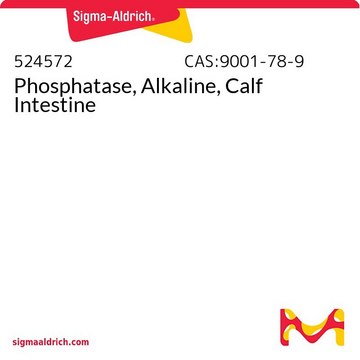10567752001
Roche
Alkaline Phosphatase
EIA grade, from calf intestine
Synonym(s):
AP, Alkaline Phosphatase
Sign Into View Organizational & Contract Pricing
All Photos(1)
About This Item
Recommended Products
biological source
bovine (calf) intestine
Quality Level
form
solution
specific activity
~3,000 U/mg enzyme protein (+37°C, 4-nitrophenyl phosphate substrate, diethanolamine as buffer)
packaging
pkg of 1.5 mL (15 mg)
manufacturer/tradename
Roche
optimum pH
9.8
pH range
9.0-11.0
shipped in
wet ice
General description
Orthophosphoric-monoester phosphohydrolase (alkaline optimum)
Amino groups: 8-16 moles/mole enzyme
Amino groups: 8-16 moles/mole enzyme
Application
Alkaline phosphatase can be coupled to other proteins via its amino groups. The enzyme solution can be used directly for conjugation without prior dialysis.
Quality
Purity: single peak (HPLC)
Sequence
Purification procedure
AP from intestine is a dimeric glycoprotein, it is not known, whether the carbohydrate part is separated during purification procedure. Content of amino groupsIn the literature the carbohydrate content is 2 to 20 percent so one should find approx. 70 amino groups/mol.
In addition one researcher determined the amino groups and found 50 to 60 lysins/mol.-SH groups in AP
No information in literature about -SH groups in AP.
Carbohydrate structure
Results of investigation of the carbohydrate structure of several lots of alkaline phosphatase are available.
NH2- and carbohydrate estimation
Results of NH2- and carbohydrate estimation are available.
AP from intestine is a dimeric glycoprotein, it is not known, whether the carbohydrate part is separated during purification procedure. Content of amino groupsIn the literature the carbohydrate content is 2 to 20 percent so one should find approx. 70 amino groups/mol.
In addition one researcher determined the amino groups and found 50 to 60 lysins/mol.-SH groups in AP
No information in literature about -SH groups in AP.
Carbohydrate structure
Results of investigation of the carbohydrate structure of several lots of alkaline phosphatase are available.
NH2- and carbohydrate estimation
Results of NH2- and carbohydrate estimation are available.
Unit Definition
Unit Conversion: Approx. 4.35 U (EIA grade AP) [37 °C, 4-NPP as substrate, diethanolamine as buffer, pH 9.8] = 1 U [+25 °C, 4-NPP as substrate, glycine as buffer, pH 10.5]
1.0 U [+37 °C, QC assay conditions] = 0.73 U [+30 °C, QC assay conditions] = 0.48 U [+25 °C, QC assay conditions]
1.0 U [+37 °C, QC assay conditions] = 0.73 U [+30 °C, QC assay conditions] = 0.48 U [+25 °C, QC assay conditions]
Physical form
Solution, ready-to-use, 10mg/ml
Preparation Note
Storage conditions (working solution): The diluted enzyme (1:10 in 3 M NaCl) will give a stability of 6 months at 4 °C.
1:10 dilution in water will give stability for 1 week at 4°C.
Do not freeze the diluted or undiluted enzyme, because freezing will destroy enzyme activity.
1:10 dilution in water will give stability for 1 week at 4°C.
Do not freeze the diluted or undiluted enzyme, because freezing will destroy enzyme activity.
Storage and Stability
Store at 2 to 8 °C. (Do not freeze)
Other Notes
For life science research only. Not for use in diagnostic procedures.
WGK
WGK 1
Flash Point(F)
does not flash
Flash Point(C)
does not flash
Choose from one of the most recent versions:
Already Own This Product?
Find documentation for the products that you have recently purchased in the Document Library.
Customers Also Viewed
Identification of an N'-Nitrosonornicotine-Specific Deoxyadenosine Adduct in Rat Liver and Lung DNA.
Yupeng Li et al.
Chemical research in toxicology, 34(4), 992-1003 (2021-03-12)
The tobacco-specific nitrosamines N'-nitrosonornicotine (NNN) and 4-(methylnitrosamino)-1-(3-pyridyl)-1-butanone (NNK) are considered to be two of the most important carcinogens in unburned tobacco and its smoke. They readily cause tumors in laboratory animals and are classified as "carcinogenic to humans" by the
Protocols
Alkaline phosphatase (AP) is a non-specific phosphomonoester hydrolase that catalyzes the hydrolysis of a wide variety of organic monophosphates.
Our team of scientists has experience in all areas of research including Life Science, Material Science, Chemical Synthesis, Chromatography, Analytical and many others.
Contact Technical Service




